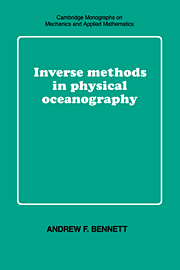Book contents
- Frontmatter
- Contents
- Preface
- 1 Finite-dimensional inverse theory
- 2 The smoothing of observations
- 3 Data assimilation
- 4 The spatial structure of the Kalman filter
- 5 Generalized inverses of dynamical models
- 6 Antenna analysis
- 7 Nonlinear quasi-geostrophic models
- 8 Open-ocean modelling: quasi-geostrophy
- 9 Primitive-equation models
- 10 Outstanding problems
- Bibliography
- Subject index
10 - Outstanding problems
Published online by Cambridge University Press: 08 January 2010
- Frontmatter
- Contents
- Preface
- 1 Finite-dimensional inverse theory
- 2 The smoothing of observations
- 3 Data assimilation
- 4 The spatial structure of the Kalman filter
- 5 Generalized inverses of dynamical models
- 6 Antenna analysis
- 7 Nonlinear quasi-geostrophic models
- 8 Open-ocean modelling: quasi-geostrophy
- 9 Primitive-equation models
- 10 Outstanding problems
- Bibliography
- Subject index
Summary
The general circulation
Introduction
The general circulation of the oceans is an essential component of the thermodynamic system which determines global climate. The contributions of the oceans to the poleward fluxes of heat and water, for example, are clearly significant if not yet reliably known (Lorenz, 1967). It is widely accepted that modeling has improved our understanding of the general ocean circulation, but the objectives of ocean modeling are evolving along with the models themselves. Goal 1 of the World Ocean Circulation Experiment (WOCE) restates the grand objective of physical oceanography:
To develop models useful for predicting climate change and to collect the data necessary to test them
(WOCE, 1988). So far models have been developed by exploring the consequences of adding ever more physics and ever more detail. The earliest developments showed that westward intensification in subtropical gyres could be attributed to a combination of the β-effect with flow at high Reynolds number (Stommel, 1948; Munk, 1950). The nonlinear effect of vorticity advection was shown by Bryan (1963) to lead to time-dependent flow on the §-plane at high Reynolds number, even if the flow is steadily forced. An imposed mean density stratification allows the Lorenz cycle of energy exchange between mean and eddy forms of available potential energy and kinetic energy (Holland & Lin, 1975a,b). Stratification, determined internally by thermodynamics, is found to develop plausible thermohaline structure in response to reasonably representative mean surface fluxes of heat, salt and momentum (Bryan & Cox, 1968a,b; Bryan & Lewis, 1979).
- Type
- Chapter
- Information
- Inverse Methods in Physical Oceanography , pp. 283 - 316Publisher: Cambridge University PressPrint publication year: 1992

